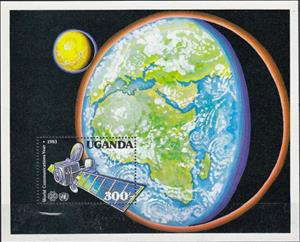Souvenir Sheet: World Communications Year- Communication by Satellite (Uganda 1983)
World Communications Year- Communication by Satellite (Uganda 1983)
01 November (Uganda ) within release World Communications Year goes into circulation Souvenir Sheet World Communications Year- Communication by Satellite face value 300 Ugandan shilling
| Souvenir Sheet World Communications Year- Communication by Satellite in catalogues | |
|---|---|
| Michel: | Mi: UG BL43 |
| Stamp Number: | Sn: UG 385 |
Souvenir Sheet is square format.
Also in the issue World Communications Year:
- Stamp - Mpoma Satellite Earth Station face value 20;
- Stamp - World Communications Year face value 50;
- Stamp - World Communications Year face value 70;
- Stamp - World Communications Year face value 100;
- Stamp - World Communications Year face value 300;
- Souvenir Sheet - World Communications Year- Communication by Satellite face value 300;
Souvenir Sheet World Communications Year- Communication by Satellite it reflects the thematic directions:
Communication is commonly defined as the transmission of information. Its precise definition is disputed and there are disagreements about whether unintentional or failed transmissions are included and whether communication not only transmits meaning but also creates it. Models of communication are simplified overviews of its main components and their interactions. Many models include the idea that a source uses a coding system to express information in the form of a message. The message is sent through a channel to a receiver who has to decode it to understand it. The main field of inquiry investigating communication is called communication studies.
A globe is a spherical model of Earth, of some other celestial body, or of the celestial sphere. Globes serve purposes similar to maps, but, unlike maps, they do not distort the surface that they portray except to scale it down. A model globe of Earth is called a terrestrial globe. A model globe of the celestial sphere is called a celestial globe
The Moon is Earth's only natural satellite. It orbits at an average distance of 384,400 km (238,900 mi), about 30 times the diameter of Earth. Tidal forces between Earth and the Moon have over time synchronized the Moon's orbital period (lunar month) with its rotation period (lunar day) at 29.5 Earth days, causing the same side of the Moon to always face Earth. The Moon's gravitational pull – and to a lesser extent, the Sun's – are the main drivers of Earth's tides.
A satellite or artificial satellite is an object, typically a spacecraft, placed into orbit around a celestial body. They have a variety of uses, including communication relay, weather forecasting, navigation (GPS), broadcasting, scientific research, and Earth observation. Additional military uses are reconnaissance, early warning, signals intelligence and, potentially, weapon delivery. Other satellites include the final rocket stages that place satellites in orbit and formerly useful satellites that later become defunct.




